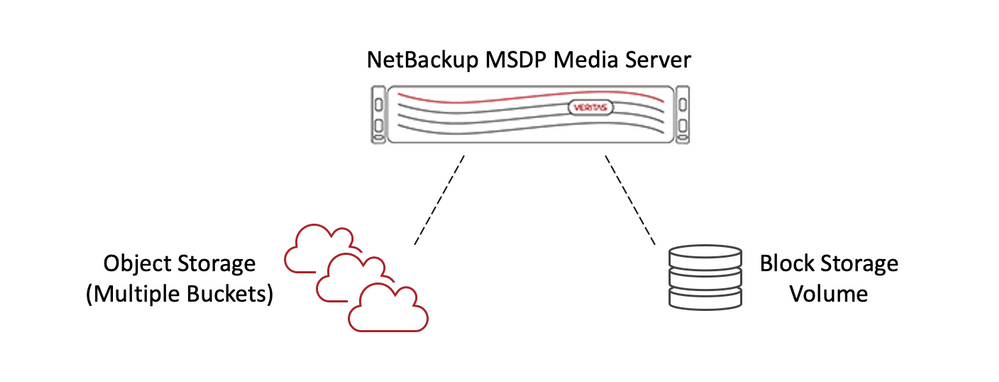Optimizing Cloud Adoption: Unified Deduplication with NetBackup MSDP Direct Cloud Tiering

Over the years, the public cloud has evolved to add many compelling features that drive customer adoption. One of these was flexible object storage, with a metered, only-pay-for-what-is-used billing model. Many organizations are choosing to replace off-site tape rotation or entire secondary data centers with cloud storage and infrastructure. This alternative approach offers several advantages, including easier access to data, future-proofing for changes in storage technology, and the ability to use cloud computing as a cost-effective “on-demand” disaster recovery site. At the same time, one of the greatest challenges that customers need to address is ballooning storage costs in the cloud. Storing backup data is of special concern due to various retention and compliance requirements.
A few years ago, Veritas anticipated this problem and worked toward a solution to help customers save money in the cloud. To drive down the costs associated with backup-to-cloud, Veritas introduced CloudCatalyst with NetBackup 8.1. CloudCatalyst provided much-needed deduplication services optimized for cloud storage platforms. This has been one of NetBackup’s most widely adopted options in recent years, with hundreds of petabytes of data being protected with over 30 different object storage platforms, both public and private.
Over time, Veritas has continued to innovate around the backup-to-cloud use case. In NetBackup 8.2, we made it even more efficient to use cloud storage as a cost-effective replacement for tape with improved performance and support for in-cloud data reuse and archive tiers. In NetBackup 8.3, we’ve built on CloudCatalyst technology to add a built-in cloud-tiering service to a standard NetBackup MSDP server, called NetBackup MSDP Direct Cloud Tiering. In other words, the capabilities that were previously part of a separate CloudCatalyst server have now been incorporated in a standard NetBackup MSDP server, eliminating the need for deployment of a separate CloudCatalyst node. After an MSDP pool is upgraded to NetBackup 8.3, you can easily add a cloud storage tier in the new web-based storage UI. (See Figure 1.)

Figure 1. The new web-based storage UI in NetBackup 8.3.
With NetBackup 8.3, any NetBackup MSDP server running on RHEL has the capability to write data to a local block-based storage volume (as it always has) to supply a quick, local recovery point. New in version 8.3, the same server can send data directly to low-cost object storage (S3-compatible or Azure) as well. In addition, this new functionality enables support for multiple cloud targets from the same server, including multiple buckets, storage tiers, and even multiple cloud providers. This capability allows on-storage tiers to fan-out data to multiple storage tiers at the same time, providing complete backup coverage with a single system.
With NetBackup 8.3, existing MSDP servers can upgrade and take advantage of the direct cloud-tiering feature. Existing CloudCatalyst servers can be upgraded to 8.3, which includes a new capability to use client-side dedupe directly to a CloudCatalyst server just like the MSDP server. An upgraded CloudCatalyst server will not be able to add a local block storage tier with this release. Watch for a future release that will introduce an upgrade path for existing CloudCatalyst servers to migrate to this merged capability.
Some of the key attributes of the MSDP cloud-tiering feature in NetBackup 8.3 include:
Fewer servers required—By enabling cloud tiering directly from an MSDP server, the need to deploy a dedicated server to provide tiering services is reduced to only environments where workload volumes dictate dedicated resources. Many environments will be able to use existing server resources to write data directly to object storage, reducing the hardware cost and operational complexity of additional nodes. Not only does this approach decrease the data center footprint, but it also simplifies the overall cost and administration.
Deployment flexibility—As always, you can deploy NetBackup as a physical BYO server, a converged appliance model, virtual instances, a Flex Appliance-based container, and cloud-native instances.
Efficiency improvements—The new MSDP architecture uses a dynamic cache-sharing model. No dedicated cache is required. The cloud-tiering feature automatically uses the local block storage pool as its write-cache. This setup creates performance and efficiency improvements and prevents a network hop or a cache write when writing to cloud object storage.
Multiple buckets/tiers/cloud vendors—By supporting multiple object storage targets, a single MSDP server can write to multiple cloud buckets, including different storage tiers, or even different cloud vendors. (See Figure 2.) This broad support offers great administrative efficiency as well as cost savings.

Figure 2. In NetBackup 8.3, a single MSDP server can write to multiple cloud buckets and cloud vendors.
With NetBackup 8.3, Veritas has continued to innovate in this area of cloud storage. This newest update takes a leading solution that was built around cloud storage savings and makes it easier to use, more flexible, and even lowers the cost further. Veritas has continued to focus on the goal of delivering as much value as possible to customers while ensuring they can operate at the capacity, scale, and reliability their demanding business needs dictate.
To learn more about how NetBackup 8.3 can help you streamline your cloud adoption safely and protect your data in the cloud and beyond, visit veritas.com.
